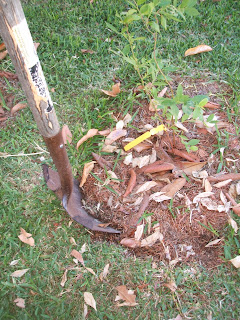With the need to get the plants in the ground before the late season heat set in, my husband and I dug holes in the lawn and planted them right there in the grass. This didn't work out well. The scrawny plants kept getting stepped on or I would drag the hose over them while watering. I tried using bricks and metal cages to protect them but it wasn't working and I knew it wouldn't be long before the plants would be dead.
I've seen projects using wine bottles to edge pathways and borders, and I thought I would give it a try around my berry plants.
I work in a restaurant so I have easy access to lots of empty wine bottles. I also love wine, so it wasn't hard to come up with enough bottles for this project, however one border takes 20 bottles so if I'm going to edge around all my berry plants, or along a pathway for that matter, I better get crackin' on drinking/saving bottles.
I start by digging out a circle around the blueberry plant.
I placed a bottle upside down in the hole. I don't have a mallet so I placed an old rag on top of the bottle and used a brick to pound the bottle in the soil.
The brick worked ok, but you can't really strike the bottle as hard as needed to enbed it deeply in the soil.
Since that was all I had to work with I continued around the circle, loosing the soil with the fork, removing the soil from the circle, adding the next bottle and pounding it in place.
When I got to the end of the circle it took a bit of time (and work) to make the bottles fit correctly. I think this was the most difficult part of the whole project.
Around this time my neighbor came over to see what I was up to. He's used to seeing the unusual happenings that go on here and he was looking for the source of the noise I was making. He lent me a rubber mallet which allowed me to strike the bottles hard and made finishing the job a breeze. I know what I'll be asking my husband for on my next birthday.
I back filled around the bottles with the soil I had removed and added some mulch around the plant and bottles.
Now I just have to hope I won't trip over it.
Be well and happy gardening!
Update 04/20/2015:
My wine bottle border stayed up for quite a while. At the end of 2014 I pulled up the bottles and the blueberry plants. The bottles were used to surround a bed of fruit trees and flowers.
FYI, I use the weed eater right up against the bottles. The weed eater has a guard that can be lowered to prevent damage to trees, fences etc.









































